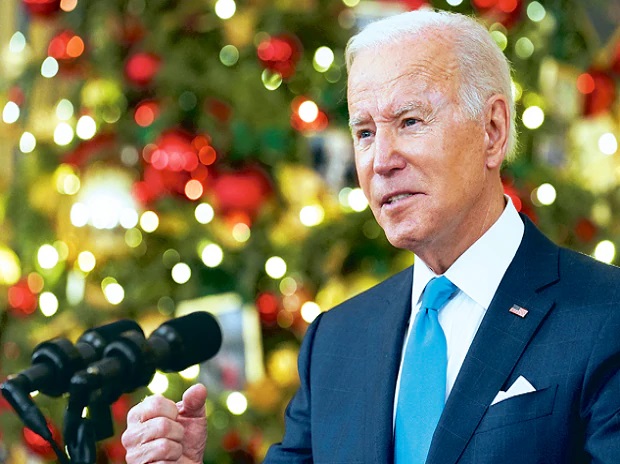Biden took office in January 2021 with a 200-page coronavirus response strategy, promising a “full-scale wartime effort” rooted in science and competence. The CDC’s July discovery marked the point at which the virus began ruthlessly exposing the challenges it would present to his management of the pandemic.
Dr. Rochelle Walensky was stunned. Working from her home outside Boston on a Friday night in late July, the director of the Centers for Disease Control and Prevention had just learned from members of her staff that vaccinated Americans were spreading the coronavirus.
Vaccines had been the core of President Joe Biden’s pandemic strategy from the moment he took office. But as Walensky was briefed about a cluster of breakthrough cases in Provincetown, Massachusetts, the reality sank in. The delta variant, which had ravaged other parts of the world, was taking hold in the United States. And being vaccinated would not, it turned out, prevent people from becoming infected with the variant or transmitting it.
It was a “heart sink” moment, Walensky recalled in a recent interview. The discovery called into question the Biden administration’s almost single-minded focus on vaccination as the path out of the pandemic. And it made Biden’s July 4 message that the nation had moved “closer than ever to declaring our independence from a deadly virus” sound naive.
Biden took office in January 2021 with a 200-page coronavirus response strategy, promising a “full-scale wartime effort” rooted in science and competence. The CDC’s July discovery marked the point at which the virus began ruthlessly exposing the challenges it would present to his management of the pandemic.
Biden and his team have gotten much right, including getting at least one dose of a vaccine into nearly 85% of Americans 12 and older and rolling out life-saving treatments. Those achievements have put the United States in a far better place to combat the virus than it was a year ago, with most schools and businesses open and the death rate lower because the vaccine significantly reduces the chance of illness or death, even from the highly contagious omicron variant.
But an examination of Biden’s first year of fighting the virus — based on interviews with scores of current and former administration officials, public health experts and governors — shows how his effort to confront “one of the most formidable enemies America has ever faced,” as he recently described it, has been marked by setbacks in three key areas:
— The White House bet the pandemic would follow a straight line, and was unprepared for the sharp turns it took. The administration did not anticipate the nature and severity of variants, even after clear warning signals from the rest of the world. And it continued to focus almost single-mindedly on vaccinations even after it became clear that the shots could not always prevent the spread of disease.
— The administration lacked a sustained focus on testing, not moving to sharply increase the supply of at-home COVID tests until the fall, with delta tearing through the country and omicron on its way. The lack of foresight left Americans struggling to find tests that could quickly determine if they were infected.
— The president tiptoed around an organized Republican revolt over masks, mandates, vaccine passports and even the vaccine itself, as he worried that pushing certain containment measures would only worsen an already intractable cultural and political divide in the country. The nation’s precarious economic health, and the political blowback that Biden and members of his party could face if it worsened, made him all the more cautious. So rather than forcing Americans to get shots, he spent months struggling to accomplish it through persuasion.
Biden took over the task of distributing vaccines from former President Donald Trump, and by all accounts he brought order to a rollout that had been dysfunctional and chaotic in its first month.
But he also inherited a bureaucracy that had been battered by the Trump White House, which undermined the CDC, strained the government’s credibility with the public and helped foment virulent anger throughout the country over masks, social distancing and other efforts to contain the virus. Biden has been unable to bridge those divisions.
Two years into the pandemic, even as the omicron variant has begun to recede in parts of the country, Biden is facing huge economic and political pressures. He has rejected lockdowns, school closures or other extreme measures that could help contain future mutations but drive the country back into a punishing recession. His decisions will carry a cost no matter which way he turns.
Biden has battled the virus while also trying to make headway on other priorities: a bipartisan infrastructure deal, appointments to the federal bench and far-reaching social spending legislation. In August and September, as delta surged, the White House was consumed by a chaotic exit from America’s 20-year war in Afghanistan.
But the pandemic loomed over everything, dragging down Biden’s approval ratings as his handling of it became for many the measuring stick by which to judge his presidency. Since he was inaugurated on Jan. 20, 2021, 438,110 people have died from the virus, a number that is still increasing by more than 10,000 people every week.
“You cannot fight today’s pandemic,” said Dr. Luciana Borio, a former acting chief scientist of the Food and Drug Administration who advised Biden’s transition team. “You have to prepare for what’s next.”
‘No Policy’
On March 2, officials from the CDC and other agencies held a conference call to discuss creating a federal “passport” to enable airlines, restaurants and other venues to electronically verify vaccination status.
A 27-page presentation prepared for the meeting underscored how critical the issue was: “A chaotic and ineffective vaccine credential approach could hamper our pandemic response by undercutting health safety measures, slowing economic recovery and undermining public trust and confidence.”
But within weeks, public health officials began hearing a different message from the White House, where Biden and his team were wary of Republican politicians like Gov. Ron DeSantis of Florida, who railed against such passports as “completely unacceptable.”
“The policy is no policy” was the unofficial word from the White House, one federal health official recalled.
The scientists at the CDC dismantled their working group, ceding to a patchwork of state and private efforts to track inoculations and the paper coronavirus vaccination record cards that can be lost or counterfeited.
By the summer, Biden’s push to get Americans vaccinated was stalling and a chorus of voices inside and outside the government was urging him to mandate the shots.
Public health experts insisted that pleading with people to get vaccinated was not enough. But most Republican governors fiercely opposed vaccine requirements, and some asserted their own considerable power to prevent schools and businesses in their states from putting them in place.
The president believed federal vaccine mandates would backfire, according to several of his advisers. He shut down the idea of requiring domestic airline passengers to be vaccinated, which Dr. Anthony Fauci, Biden’s chief medical adviser for the pandemic, has supported.
Even more modest initiatives drew instant attacks. In early July, when the administration announced an enhanced door-to-door outreach campaign to get Americans vaccinated, Rep. Jim Jordan of Ohio, a Trump ally and a frequent Biden critic, was among the many Republicans who pounced.
“The Biden Administration wants to knock on your door to see if you’re vaccinated,” he tweeted. “What’s next? Knocking on your door to see if you own a gun?”



